Australia is experiencing rising trends in the number and rate of drug-induced deaths[1]. Three people die every day from opioid-related use and over 110,000 Australians are currently struggling with opioid dependence[2], with many of these deaths caused by prescribed opioid medications. Trend analyses by ISSR researchers show that drug-related deaths have increased significantly over the past decade in Western Australia, New South Wales, Victoria and Queensland. 
Naloxone is a lifesaving drug that can temporarily reverse the effects of an opioid overdose or adverse reaction. It is widely used by paramedics and emergency department staff, and is now on the Pharmaceutical Benefit Scheme and available over the counter at pharmacies without a prescription. However, awareness and uptake of this potentially life-saving drug is not high among people at risk, who include those on prescribed opioid medications as well as people who use illicit drugs or among their families. In an attempt to address this issue the Australian Government is investing $10 million in the take home naloxone pilot program to make naloxone available for free through a broad range of services to people who may experience, or witness, an opioid overdose and they have commissioned ISSR to evaluate this pilot program.
The pilot was launched in December 2019 and is running in SA, WA and NSW, with access sites including community and hospital-based pharmacies, alcohol and drug treatment centres, needle and syringe programs, pain clinics, custodial release programs and GP clinics.
Our team, led by Dr Caroline Salom and in partnership with the National Drug and Alcohol Research Centre at the University of New South Wales, is applying a syndemics approach to this evaluation to examine the complex social, environmental and health issues that affect naloxone uptake in different groups of people. Drawing from their experience delivering the national Drug Trends research program, they will use existing administrative and research data to identify trends in opioid overdoses and collect new data from consumers and others involved in the pilot over a 14-month period. This will provide cross-state, service level and individual perspectives and experiences of the pilot; and the lessons learned will inform a prospective national roll-out.
“This pilot is important as it aims to remove the barriers of cost and availability so that a broad range of people at risk – particularly people who might not consider themselves at risk, like those on medications for chronic pain – can access naloxone and potentially save lives. Assessing the different ways each State is delivering the pilot will give us great perspective on what would be important for a national roll-out, and working with our interstate partners gives us access to a deep field of expertise in this area” - Dr Caroline Salom.
This evaluation program is well-aligned to our research expertise, where our team of multidisciplinary researchers are committed to understanding how people use drugs (both licit and illicit) in Australia and informing the most effective strategies to minimise health and social harms. This take home naloxone pilot program is an important intervention for people who are at risk of an opioid overdose as well as families and communities.
The team has developed an evaluation framework after extensive consultation with participating States and field evaluation activities commenced in January 2020.
[1] Man, N., et al., Trends in drug-induced deaths in Australia, 1997-2018. 2019, National Drug and Alcohol Research Centre, UNSW: Sydney. p. 1-14.
[2] About the take home naloxone pilot. Department of Health, 2019. https://www.health.gov.au/initiatives-and-programs/take-home-naloxone-pilot/about-the-take-home-naloxone-pilot



